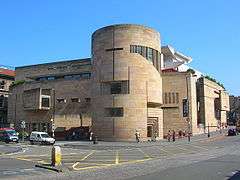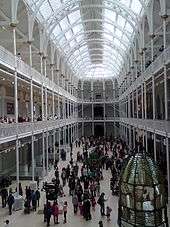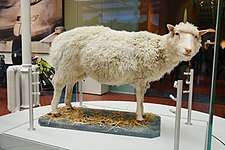National Museum of Scotland
The National Museum of Scotland in Edinburgh, Scotland, was formed in 2006 with the merger of the new Museum of Scotland, with collections relating to Scottish antiquities, culture and history, and the adjacent Royal Scottish Museum (so renamed in 1904), with collections covering science and technology, natural history, and world cultures. The two connected buildings stand beside each other on Chambers Street, by the intersection with the George IV Bridge, in central Edinburgh. The museum is part of National Museums Scotland. Admission is free.
| National Museum of Scotland | |
|---|---|
 The Museum of Scotland building, part of the National Museum of Scotland | |
 | |
| General information | |
| Architectural style | Victorian Venetian Renaissance and modern |
| Town or city | Edinburgh |
| Country | Scotland |
| Coordinates | 55°56′49″N 3°11′24″W |
| Construction started | 1861 |
| Completed | 1866 and 1998 |
| Inaugurated | 1866 |
| Renovated | 2011 |
| Design and construction | |
| Architect | Benson & Forsyth |
| Structural engineer | Anthony Hunt Associates |
| Website | |
| www | |
The two buildings retain distinctive characters: the Museum of Scotland is housed in a modern building opened in 1998, while the former Royal Museum building was begun in 1861 and partially opened in 1866, with a Victorian Venetian Renaissance facade and a grand central hall of cast iron construction that rises the full height of the building. This building underwent a major refurbishment and reopened on 29 July 2011 after a three-year, £47 million project to restore and extend the building led by Gareth Hoskins Architects along with the concurrent redesign of the exhibitions by Ralph Appelbaum Associates.[1]
The National Museum incorporates the collections of the former National Museum of Antiquities of Scotland. As well as the national collections of Scottish archaeological finds and medieval objects, the museum contains artefacts from around the world, encompassing geology, archaeology, natural history, science, technology, art, and world cultures. The 16 new galleries reopened in 2011 include 8,000 objects, 80 per cent of which were not formerly on display.[2] One of the more notable exhibits is the stuffed body of Dolly the sheep, the first successful cloning of a mammal from an adult cell. Other highlights include Ancient Egyptian exhibitions, one of Elton John's extravagant suits, the Jean Muir Collection of costume and a large kinetic sculpture named the Millennium Clock. A Scottish invention that is a perennial favourite with school parties is the Scottish Maiden, an early form of guillotine.
In 2018, the museum received 2,227,773 visitors, making it Scotland's most popular visitor attraction that year.[3]
History
The history of the museum can be said to begin in 1780 with the foundation of the Society of Antiquaries of Scotland, which still continues, but whose collection of archaeological and other finds was transferred to the government in 1858 as the National Museum of Antiquities of Scotland, from 1891 sharing the same building as the Scottish National Portrait Gallery in Queen Street in the New Town, Edinburgh.[4]
In 1861 construction in Chambers Street of the Industrial Museum of Scotland began, with Prince Albert laying the foundation stone. In 1866, renamed the Edinburgh Museum of Science and Art, the eastern end and the Grand Gallery were opened by Prince Alfred. In 1888 the building was finished and in 1904 the institution was renamed the Royal Scottish Museum.[5]
The organizational merger of the National Museum of Antiquities of Scotland and the Royal Scottish Museum took place in 1985, but the two collections retained separate buildings until 1995 when the Queen Street building closed, to reopen later occupied solely by the Scottish National Portrait Gallery. In 1998 the new Museum of Scotland building opened, adjacent to the Royal Museum building, and connected to it. The masterplan to redevelop the Victorian building and further integrate the architecture and collections was launched in 2004, and in 2006 the two museums were formally merged as the National Museum of Scotland.[5] The old Royal Museum building closed for redevelopment in 2008, before reopening in July 2011.[2][6]
The Royal Scottish Museum displayed prank exhibits on April Fool's Day on at least one occasion. In 1975, a fictitious bird called the Bare-fronted Hoodwink (known for its innate ability to fly away from observers before they could accurately identify it) was put on display. The exhibit included photos of blurry birds flying away. To make the exhibit more convincing, a mount of the bird was sewn together by a taxidermist from various scraps of real birds, including the head of a carrion crow, the body of a plover, and the feet of an unknown waterfowl. The bare front was composed of wax.[7]
Staff at the museum took several days of strike action at points during 2015 and 2016, called by the Public and Commercial Services Union.[8][9][10]
Architecture

Royal Museum building
Construction was started in 1861 and proceeded in phases, with some sections opening before others had even begun construction. The original extent of the building was completed in 1888. It was designed by civil engineer Captain Francis Fowke of the Royal Engineers, who is also responsible for the Royal Albert Hall. The exterior, designed in a Venetian Renaissance style, contrasts sharply with the light-flooded main hall or Grand Gallery, inspired by The Crystal Palace.[11]
| Wikinews has related news: |
Numerous extensions at the rear of the building, particularly in the 1930s, extended the museum greatly. 1998 saw the opening of the Museum of Scotland, which is linked internally to the Royal Museum building. The major redevelopment completed in 2011 by Gareth Hoskins Architects uses former storage areas to form a vaulted Entrance Hall of 1400 sq M at street level with visitor facilities. This involved lowering the floor level by 1.2 metres. Despite being a Class A listed building, it was possible to add lifts and escalators.[2]
Museum of Scotland building
The building is made up of geometric, Corbusian forms, but also has numerous references to Scotland, such as brochs and castellated defensive architecture. It is clad in golden Moray sandstone, which one of its architects, Gordon Benson, has called "the oldest exhibit in the building", a reference to Scottish geology. The building was a 1999 Stirling Prize nominee.[12]
Collections
The galleries in the newer building present Scottish history in an essentially chronological arrangement, beginning at the lowest level with prehistory to the early medieval period, with later periods on the higher levels. The Victorian building, as reopened in 2011, contains four zones (each with numerous galleries), covering natural history, world cultures (including galleries on the South Pacific, East Asia, and Ancient Egypt), European art and design, and science & technology. The Grand Gallery contains a variety of large objects from the collections, with a display called the "Window on the World" rising through four storeys, or about 20 metres, containing over 800 objects reflecting the breadth of the collections. Beyond the Grand Gallery at ground level is the "Discoveries" gallery, with objects connected to "remarkable Scots ... in the fields of invention, exploration and adventure".[13] Notable artifacts include:
- Assyrian relief of King Ashurnasirpal II and a court official
- Monymusk Reliquary
- St Ninian's Isle Treasure
- 11 of the Lewis chessmen. (The rest are owned by the British Museum)
- Celtic brooches, including the Hunterston Brooch
- Torrs Pony-cap and Horns
- Pictish stones, such as the Hilton of Cadboll Stone, Woodwrae Stone, and Monifieth Sculptured Stones
- the Cramond Lioness, Newstead Helmet and other items from the Roman frontier
- The Lunnasting stone
- Whitecleuch Chain
- Migdale Hoard
- Bute mazer
- Sculptures by Sir Eduardo Paolozzi, housing prehistoric jewellery
- A Union Flag and Scottish Flag raised by the Hanoverians and Jacobites respectively at the Battle of Culloden
- The Maiden, an early form of guillotine
- the stuffed remains of Dolly the sheep[14]
- Paintings by Margaret MacDonald
- Sculptures by Andy Goldsworthy, inspired by the work of Scottish geologist James Hutton
Gallery
 Detail of chape from the St Ninian's Isle Treasure
Detail of chape from the St Ninian's Isle Treasure Some of the 11 Lewis chessmen in Edinburgh
Some of the 11 Lewis chessmen in Edinburgh Stegosaurus fossil on display
Stegosaurus fossil on display Taxidermy of Dolly (sheep) on display
Taxidermy of Dolly (sheep) on display
See also
- Gordon Rintoul, Director
- List of most visited art museums in the world
References
- "National Museum of Scotland to reopen after £47m refit". BBC. 27 July 2011. Retrieved 20 December 2011.
- NMS press release for the reopening
- "ALVA - Association of Leading Visitor Attractions". www.alva.org.uk. Retrieved 25 April 2019.
- "National Museums Scotland Archive". Archives Hub. Retrieved 25 June 2018.
- Miller, Phil (14 October 2006). "Museum drops its royal title to avoid confusion among visitors Queen gives her seal of approval to changing name of building after 102 years". The Herald. Retrieved 11 October 2016.
- Brown, Mark (28 July 2011). "New National Museum of Scotland unveiled after £47m revamp". The Guardian. Retrieved 30 October 2016.
- "The Bare-Fronted Hoodwink". Museumofhoaxes.com. 1 April 1975. Retrieved 20 December 2011.
- "National Museum of Scotland staff take strike action". BBC News. 24 August 2015. Retrieved 18 December 2016.
- "National Museum of Scotland staff walk out". BBC News. 16 April 2015. Retrieved 18 December 2016.
- "National Museum of Scotland workers step up strike in pay row". BBC News. 18 March 2016. Retrieved 18 December 2016.
- "The Royal Scottish Museum". Victorian Web. Retrieved 24 June 2018.
- "Twenty years of the RIBA Stirling Prize". Architect's Journal. 6 October 2015. Retrieved 24 June 2018.
- NMS press release on reopening
- "UK | Scotland | Dolly goes on display". BBC News. 9 April 2003. Retrieved 7 April 2012.
External links
| Wikimedia Commons has media related to National Museum of Scotland. |